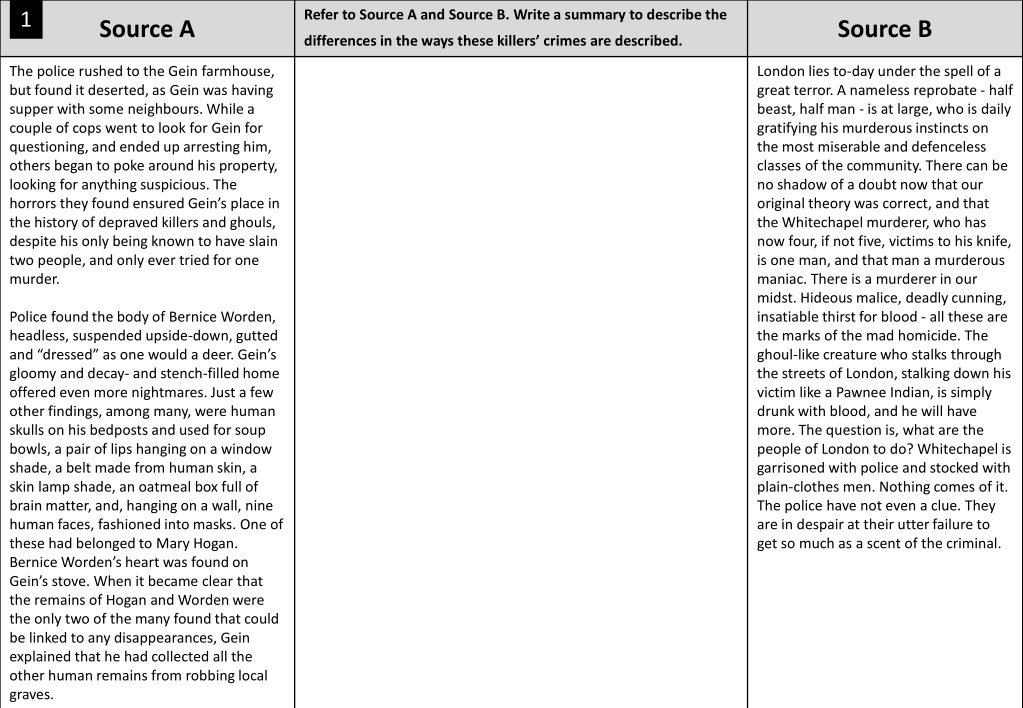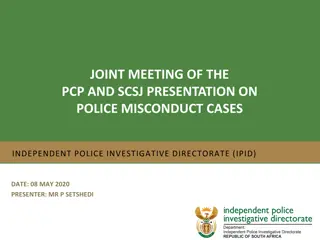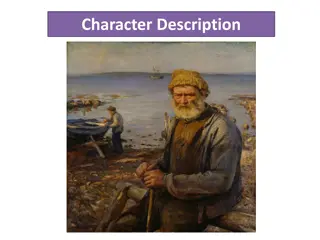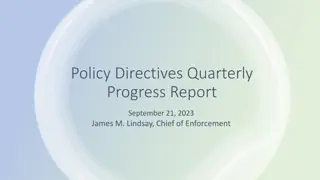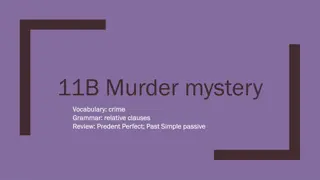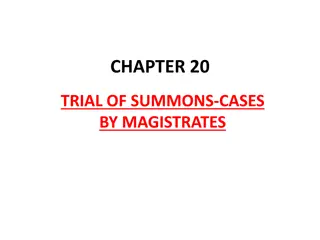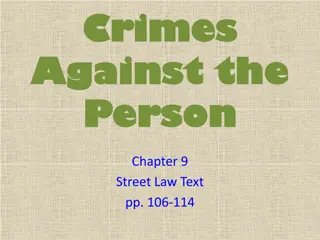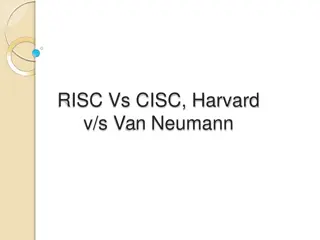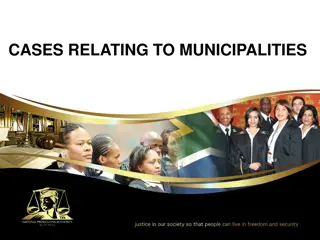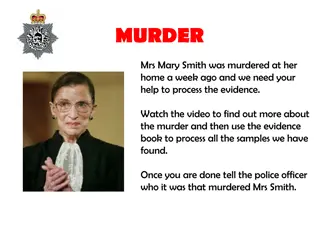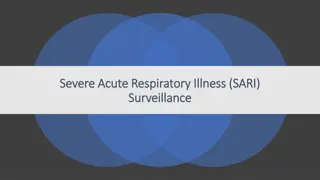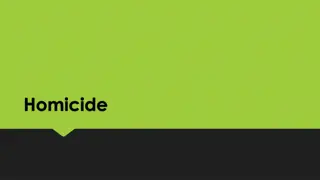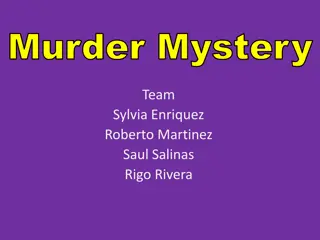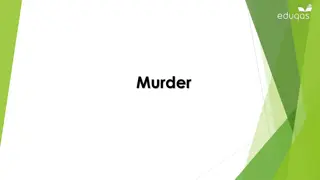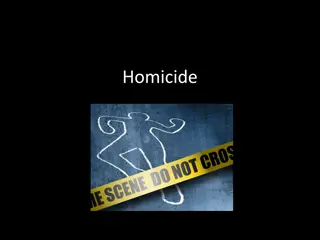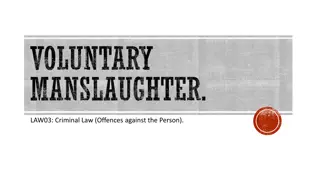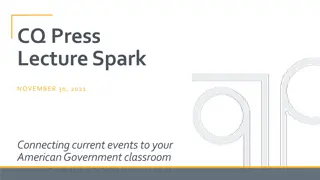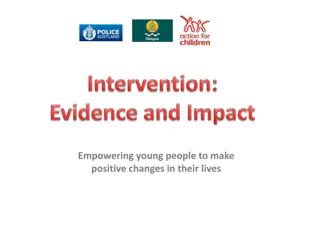Contrasting Descriptions of Notorious Murder Cases
Source A describes the gruesome findings at Gein's farmhouse, highlighting the shocking details of his crimes, whereas Source B portrays the chilling atmosphere surrounding the Whitechapel murders in London, emphasizing the elusive and bloodthirsty nature of the killer. The differences lie in the narrative styles and the specific details highlighted in each case.
Download Presentation

Please find below an Image/Link to download the presentation.
The content on the website is provided AS IS for your information and personal use only. It may not be sold, licensed, or shared on other websites without obtaining consent from the author. Download presentation by click this link. If you encounter any issues during the download, it is possible that the publisher has removed the file from their server.
E N D
Presentation Transcript
Refer to Source A and Source B. Write a summary to describe the 1 Source A Source B differences in the ways these killers crimes are described. The police rushed to the Gein farmhouse, but found it deserted, as Gein was having supper with some neighbours. While a couple of cops went to look for Gein for questioning, and ended up arresting him, others began to poke around his property, looking for anything suspicious. The horrors they found ensured Gein s place in the history of depraved killers and ghouls, despite his only being known to have slain two people, and only ever tried for one murder. London lies to-day under the spell of a great terror. A nameless reprobate - half beast, half man - is at large, who is daily gratifying his murderous instincts on the most miserable and defenceless classes of the community. There can be no shadow of a doubt now that our original theory was correct, and that the Whitechapel murderer, who has now four, if not five, victims to his knife, is one man, and that man a murderous maniac. There is a murderer in our midst. Hideous malice, deadly cunning, insatiable thirst for blood - all these are the marks of the mad homicide. The ghoul-like creature who stalks through the streets of London, stalking down his victim like a Pawnee Indian, is simply drunk with blood, and he will have more. The question is, what are the people of London to do? Whitechapel is garrisoned with police and stocked with plain-clothes men. Nothing comes of it. The police have not even a clue. They are in despair at their utter failure to get so much as a scent of the criminal. Police found the body of Bernice Worden, headless, suspended upside-down, gutted and dressed as one would a deer. Gein s gloomy and decay- and stench-filled home offered even more nightmares. Just a few other findings, among many, were human skulls on his bedposts and used for soup bowls, a pair of lips hanging on a window shade, a belt made from human skin, a skin lamp shade, an oatmeal box full of brain matter, and, hanging on a wall, nine human faces, fashioned into masks. One of these had belonged to Mary Hogan. Bernice Worden s heart was found on Gein s stove. When it became clear that the remains of Hogan and Worden were the only two of the many found that could be linked to any disappearances, Gein explained that he had collected all the other human remains from robbing local graves.
2 Refer to Source A and Source B. Write a summary to explain the different attitudes to the discoveries made. Source A Source B It was sometime before I could see as the hot air escaping caused the candle to flicker, but as soon as my eyes became accustomed to the glimmer of light the interior of the chamber gradually loomed before me, with its strange and wonderful medley of extraordinary and beautiful objects heaped upon one another In another harbour not far away, a woman, who was suckling a recently-born child, came one day alongside our ship, and remained there out of mere curiosity, whilst the sleet fell and thawed on her naked body, and on the skin of her naked baby! These poor wretches were stunted in their growth, their hideous faces decorated with white paint, their skins filthy and greasy, their hair entangled, their voices unpleasant, and their gestures violent. Viewing such men, it is difficult to accept they are fellow human beings, inhabitants of the same world. There was naturally some suspense for those present who could not yet see, because when Lord Carnarvon said to me Can you see anything? I replied to him Yes, wonderful things. I then carefully made the hole large enough for both of us to see. With the light of an electric torch as well as an additional candle, we looked in. At night five or six human beings, naked and scarcely protected from the wind and rain of this stormy climate, sleep on the wet ground coiled up like animals. Whenever it is low tide, winter or summer, night or day, they must pick shellfish from the rocks; and the women either dive to collect sea-eggs, or sit patiently in their canoes, and with a baited hair-line without any hook, jerk out little fish. If a seal is killed, or the floating carcass of a rotting whale is discovered, it is a feast; and such miserable food is assisted by a few tasteless berries and fungi. Our sensations and astonishment are difficult to describe as the better light revealed to us the marvellous collection of treasures : two strange ebony-black statues of a King, gold- sandalled, loomed out from the cloak of darkness; gilded couches in strange forms, lion-headed, Hathor-headed, and beast infernal; exquisitely painted, inlaid, and ornamental caskets; alabaster vases, strange black shrines, with a gilded monster snake appearing from within; quite ordinary looking white chests; finely carved chairs; a golden inlaid throne; beneath our very eyes, in the doorway, a lovely wishing-cup made from alabaster; and, lastly, a confusion of overturned parts of chariots glinting with gold, peering from amongst which was a statue.
2 Refer to Source A and Source B. Write a summary to explain the different attitudes to the discoveries made. Source A Source B It was sometime before I could see as the hot air escaping caused the candle to flicker, but as soon as my eyes became accustomed to the glimmer of light the interior of the chamber gradually loomed before me, with its strange and wonderful medley of extraordinary and beautiful objects heaped upon one another In another harbour not far away, a woman, who was suckling a recently-born child, came one day alongside our ship, and remained there out of mere curiosity, whilst the sleet fell and thawed on her naked body, and on the skin of her naked baby! These poor wretches were stunted in their growth, their hideous faces decorated with white paint, their skins filthy and greasy, their hair entangled, their voices unpleasant, and their gestures violent. Viewing such men, it is difficult to accept they are fellow human beings, inhabitants of the same world. Charles Darwin, the author of Source A, has a rather negative attitude towards the Fuegian people whom he encounters. He first describes He then writes about another harbour, not far away. He encounters There was naturally some suspense for those present who could not yet see, because when Lord Carnarvon said to me Can you see anything? I replied to him Yes, wonderful things. I then carefully made the hole large enough for both of us to see. With the light of an electric torch as well as an additional candle, we looked in. He finishes by describing the landscape of these islands. He thinks At night five or six human beings, naked and scarcely protected from the wind and rain of this stormy climate, sleep on the wet ground coiled up like animals. Whenever it is low tide, winter or summer, night or day, they must pick shellfish from the rocks; and the women either dive to collect sea-eggs, or sit patiently in their canoes, and with a baited hair-line without any hook, jerk out little fish. If a seal is killed, or the floating carcass of a rotting whale is discovered, it is a feast; and such miserable food is assisted by a few tasteless berries and fungi. Our sensations and astonishment are difficult to describe as the better light revealed to us the marvellous collection of treasures : two strange ebony-black statues of a King, gold- sandalled, loomed out from the cloak of darkness; gilded couches in strange forms, lion-headed, Hathor-headed, and beast infernal; exquisitely painted, inlaid, and ornamental caskets; alabaster vases, strange black shrines, with a gilded monster snake appearing from within; quite ordinary looking white chests; finely carved chairs; a golden inlaid throne; beneath our very eyes, in the doorway, a lovely wishing-cup made from alabaster; and, lastly, a confusion of overturned parts of chariots glinting with gold, peering from amongst which was a statue. However, the author of Source B has a very positiveattitude to his discovery. He begins byexplaining Then the writer describes the wonderful treasures he saw, such as He finishes by explaining
2 Refer to Source A and Source B. Write a summary to explain the different attitudes to the discoveries made. Source A Source B It was sometime before I could see as the hot air escaping caused the candle to flicker, but as soon as my eyes became accustomed to the glimmer of light the interior of the chamber gradually loomed before me, with its strange and wonderful medley of extraordinary and beautiful objects heaped upon one another In another harbour not far away, a woman, who was suckling a recently-born child, came one day alongside our ship, and remained there out of mere curiosity, whilst the sleet fell and thawed on her naked body, and on the skin of her naked baby! These poor wretches were stunted in their growth, their hideous faces decorated with white paint, their skins filthy and greasy, their hair entangled, their voices unpleasant, and their gestures violent. Viewing such men, it is difficult to accept they are fellow human beings, inhabitants of the same world. The author of Source A has a ____________________________ attitude to his discovery. He describes the way that the Fuegians dress, commenting on the _________________ skins they use to convey his opinion that they are primitive people in comparison to himself. He even comments on one woman s _________________________, indicating how shocked he is by the different way that they live. He is very ___________________ of their appearance, calling them poor wretches and complaining that they have hideous faces and filthy and greasy skin with __________________ hair. He also criticises the Fuegian ______________ and is disgusted that they will feast on the rotting corpse of a whale that washes up on the beach. He says their diet is miserable . There was naturally some suspense for those present who could not yet see, because when Lord Carnarvon said to me Can you see anything? I replied to him Yes, wonderful things. I then carefully made the hole large enough for both of us to see. With the light of an electric torch as well as an additional candle, we looked in. At night five or six human beings, naked and scarcely protected from the wind and rain of this stormy climate, sleep on the wet ground coiled up like animals. Whenever it is low tide, winter or summer, night or day, they must pick shellfish from the rocks; and the women either dive to collect sea-eggs, or sit patiently in their canoes, and with a baited hair-line without any hook, jerk out little fish. If a seal is killed, or the floating carcass of a rotting whale is discovered, it is a feast; and such miserable food is assisted by a few tasteless berries and fungi. However, the author of Source B has a very ____________________ attitude to his discovery. He describes how they cleared the passage feverishly or with ________________________, so they could gain access to the sealed door. He remembers wondering what might be hidden behind it. Then he describes looking through a small ______________ and seeing a variety of objects he refers to as strange , wonderful , and extraordinary. He is excited by the fact that there is another room beyond this one and he eagerly hopes that he will discover the ___________________ of the Ancient Egyptian king, Tutankhamen. Our sensations and astonishment are difficult to describe as the better light revealed to us the marvellous collection of treasures : two strange ebony-black statues of a King, gold- sandalled, loomed out from the cloak of darkness; gilded couches in strange forms, lion-headed, Hathor-headed, and beast infernal; exquisitely painted, inlaid, and ornamental caskets; alabaster vases, strange black shrines, with a gilded monster snake appearing from within; quite ordinary looking white chests; finely carved chairs; a golden inlaid throne; beneath our very eyes, in the doorway, a lovely wishing-cup made from alabaster; and, lastly, a confusion of overturned parts of chariots glinting with gold, peering from amongst which was a statue. WORD BOX: Use each word only once. hole Tomb diet excitement nakedness matted positive critical negative animal
QUESTION 4: Compare how both writers show their attitudes towards the discoveries they have made. (16 marks) Bronze: Use 2 quotes from each extract which show how the writer feels Silver: zoom in on the language being used and its effect on the reader Gold: analyse the methods used by the writers to show their attitudes PLAN Source A: In another harbour not far away, a woman, who was suckling a recently-born child, came one day alongside our ship, and remained there out of mere curiosity, whilst the sleet fell and thawed on her naked body, and on the skin of her naked baby! These poor wretches were stunted in their growth, their hideous faces decorated with white paint, their skins filthy and greasy, their hair entangled, their voices unpleasant, and their gestures violent. Viewing such men, it is difficult to accept they are fellow human beings, inhabitants of the same world. METHOD: ZOOM IN: ZOOM OUT: At night five or six human beings, naked and scarcely protected from the wind and rain of this stormy climate, sleep on the wet ground coiled up like animals. Whenever it is low tide, winter or summer, night or day, they must pick shellfish from the rocks; and the women either dive to collect sea-eggs, or sit patiently in their canoes, and with a baited hair-line without any hook, jerk out little fish. If a seal is killed, or the floating carcass of a rotting whale is discovered, it is a feast; and such miserable food is assisted by a few tasteless berries and fungi. METHOD 2: ZOOM IN: ZOOM OUT: SOURCE B: It was sometime before I could see as the hot air escaping caused the candle to flicker, but as soon as my eyes became accustomed to the glimmer of light the interior of the chamber gradually loomed before me, with its strange and wonderful medley of extraordinary and beautiful objects heaped upon one another METHOD: ZOOM IN: ZOOM OUT: With the light of an electric torch as well as an additional candle, we looked in. METHOD 2: Our sensations and astonishment are difficult to describe as the better light revealed to us the marvellous collection of treasures exquisitely painted, inlaid, and ornamental caskets; finely carved chairs; a golden inlaid throne; beneath our very eyes, in the doorway, a lovely wishing-cup made from alabaster ZOOM IN: ZOOM OUT:
3 Refer to Source A and Source B. Write a summary to describe the differences in the ways homelessness is described. Source A Source B Paddy was my mate for about the next fortnight, and, as he was the first tramp I had known at all well, I want to give an account of him. I believe that he was a typical tramp and there are tens of thousands in England like him. A police spokeswoman told Mail Online: As far as we know the man isn't actually homeless. He is just sitting shivering and people feel sorry for him. If he doesn't actually ask for money, he hasn't broken the law. He was a tallish man, aged about thirty- five, with fair hair going grey and watery blue eyes. His features were good, but his cheeks had sunk and had that greyish, dirty in the grain look that comes of a bread and margarine diet. He was dressed, rather better than most tramps, in a tweed shooting-jacket and a pair of old suit trousers. He was bothered about his appearance, and carried a razor and boot brush that he would not sell even though one could tell he was a tramp from one hundred yards away. She added: People will just feel sorry for him and say 'here's a tenner mate'. That's what we believe is happening. Officers say the large sum of money suggests the man may be one of a group of all-British 'hardcore' beggars they fear are operating in the city. Chief Inspector Shaun Ostle of Nottinghamshire Police said: This shows they are basically conning people. He said it was three days' work. Finding that amount of money on someone like that doesn't surprise us any more which is perhaps the more worrying thing, really . Mr Ostle says he believes some of the group have been posing as Big Issue sellers in the city, adding: They have been stopped before with similar amounts on them. It just shows that when some of these people ask for money it is just a scam. People need to understand they are being conned. He went on to say: These people have more than enough so they don't need to go on begging. He had been brought up in Ireland, served two years in the war, and then worked in a factory but he had lost his job two years earlier. He was horribly ashamed of being a tramp, but he had picked up all a tramp s habits. He browsed the pavements endlessly, never missing a cigarette end, or even an empty cigarette packet, as he used the foil paper for rolling cigarettes. He did not commit crime, however. Once, Paddy noticed a bottle of milk on a doorstep, evidently left there by mistake. He stopped, eyeing up the bottle hungrily.
3 Refer to Source A and Source B. Write a summary to describe the differences in the ways homelessness is described. Source A Source B Paddy was my mate for about the next fortnight, and, as he was the first tramp I had known at all well, I want to give an account of him. I believe that he was a typical tramp and there are tens of thousands in England like him. George Orwell, the author of Source A, has a positive attitude towards homeless people. He describes a tramp he met called Paddy, who A police spokeswoman told Mail Online: As far as we know the man isn't actually homeless. He is just sitting shivering and people feel sorry for him. If he doesn't actually ask for money, he hasn't broken the law. He was a tallish man, aged about thirty- five, with fair hair going grey and watery blue eyes. His features were good, but his cheeks had sunk and had that greyish, dirty in the grain look that comes of a bread and margarine diet. He was dressed, rather better than most tramps, in a tweed shooting-jacket and a pair of old suit trousers. He was bothered about his appearance, and carried a razor and boot brush that he would not sell even though one could tell he was a tramp from one hundred yards away. Paddy might have been homeless but he was not a criminal. To show that Paddy is honest, the writer describes how She added: People will just feel sorry for him and say 'here's a tenner mate'. That's what we believe is happening. Officers say the large sum of money suggests the man may be one of a group of all-British 'hardcore' beggars they fear are operating in the city. He finishes by explaining that Paddy might have been poor but he was a generous person. To show that Paddy is generous, Chief Inspector Shaun Ostle of Nottinghamshire Police said: This shows they are basically conning people. He said it was three days' work. Finding that amount of money on someone like that doesn't surprise us any more which is perhaps the more worrying thing, really . Mr Ostle says he believes some of the group have been posing as Big Issue sellers in the city, adding: They have been stopped before with similar amounts on them. It just shows that when some of these people ask for money it is just a scam. People need to understand they are being conned. He went on to say: These people have more than enough so they don't need to go on begging. However, the writer of Source B has a very negativeattitude to homeless people. In the newspaper headline, the word He had been brought up in Ireland, served two years in the war, and then worked in a factory but he had lost his job two years earlier. He was horribly ashamed of being a tramp, but he had picked up all a tramp s habits. He browsed the pavements endlessly, never missing a cigarette end, or even an empty cigarette packet, as he used the foil paper for rolling cigarettes. He did not commit crime, however. Once, Paddy noticed a bottle of milk on a doorstep, evidently left there by mistake. He stopped, eyeing up the bottle hungrily. The writer tells a story about a beggarwho The police officer also has a negative opinion about the beggars. He says
3 Refer to Source A and Source B. Write a summary to describe the differences in the ways homelessness is described. Source A Source B Paddy was my mate for about the next fortnight, and, as he was the first tramp I had known at all well, I want to give an account of him. I believe that he was a typical tramp and there are tens of thousands in England like him. A police spokeswoman told Mail Online: As far as we know the man isn't actually homeless. He is just sitting shivering and people feel sorry for him. If he doesn't actually ask for money, he hasn't broken the law. The author of Source A has a ____________________________ attitude to the homeless. He describes a ___________________ called Paddy who he spent some time with, to get to know. Paddy was homeless but he was horribly ashamed of being a tramp. The writer points out that He was a tallish man, aged about thirty- five, with fair hair going grey and watery blue eyes. His features were good, but his cheeks had sunk and had that greyish, dirty in the grain look that comes of a bread and margarine diet. He was dressed, rather better than most tramps, in a tweed shooting-jacket and a pair of old suit trousers. He was bothered about his appearance, and carried a razor and boot brush that he would not sell even though one could tell he was a tramp from one hundred yards away. She added: People will just feel sorry for him and say 'here's a tenner mate'. That's what we believe is happening. Officers say the large sum of money suggests the man may be one of a group of all-British 'hardcore' beggars they fear are operating in the city. Paddy did not commit crime and never _________________ things, even though he was often hungry and _____________________. Also, the writer tells us that it was not Paddy s fault he was homeless. He had lost his ___________________ two years earlier . Chief Inspector Shaun Ostle of Nottinghamshire Police said: This shows they are basically conning people. He said it was three days' work. Finding that amount of money on someone like that doesn't surprise us any more which is perhaps the more worrying thing, really . Mr Ostle says he believes some of the group have been posing as Big Issue sellers in the city, adding: They have been stopped before with similar amounts on them. It just shows that when some of these people ask for money it is just a scam. People need to understand they are being conned. He went on to say: These people have more than enough so they don't need to go on begging. However, the author of Source B has a very _____________________ attitude to the homeless. In the _______________________ he calls one homeless man a nuisance beggar and he uses the word scrounging instead of He had been brought up in Ireland, served two years in the war, and then worked in a factory but he had lost his job two years earlier. He was horribly ashamed of being a tramp, but he had picked up all a tramp s habits. He browsed the pavements endlessly, never missing a cigarette end, or even an empty cigarette packet, as he used the foil paper for rolling cigarettes. He did not commit crime, however. Once, Paddy noticed a bottle of milk on a doorstep, evidently left there by mistake. He stopped, eyeing up the bottle hungrily. the word begging to make the reader look down on the homeless man. They describe him as a ________________________ but they are not sure whether this is true or not because the police woman says: As far as we know, the man isn t actually homeless, so they are not sure. WORD BOX: Use each word only once. conman sympathetic job negative stole headline thirsty tramp
4 Refer to Source A and Source B. Write a summary of the different perspectives of the sinking of the Titanic. Source A Source B 'We can keep the water out for a while.' Then I realise the horror of an accident at sea. I dressed quickly, putting on a coat and skirt; slippers were quicker than put on than shoes; the stewardess put on our life-jackets, and we were then taken to the deck above At 11:40 pm on April 14, 1912, the two lookouts on duty, Fredrick Fleet and Reginald Lee spotted a large mass of ice and immediately rang the warning bell three times. DING! DING! DING! was all that the captain heard as he hurriedly gave the order hard-a-starboard , meaning an abrupt turn toward the left. The iceberg managed to brush the right- side of the ship crushing the hull. The Titanic s safe design included water-tight compartments that would allow the ship to stay floating in case of a minor incident. However, the ship could only stay floating as long as less than 5 compartments were filled; 5 compartments were filling fast. Several ships hear the Titanic s calls for help but are too far away to be of any assistance. The ship s crew members were given the awful job of trying to persuade reluctant passengers that the boat was really sinking. Many passengers only heard a dull scraping noise as the ice went past the ship s side and went back to sleep. Now only pale faces, each person wearing a life jacket. So gruesome a scene. We passed on. I heard the awful good-byes. I saw the quiet look of hope in the brave men's eyes as their wives were put into the lifeboats. Nothing escaped me at this fearful moment. We left from the sun deck, seventy-five feet above the water. Mr Case and Mr Roebling, brave American men, helped us into the lifeboat but made no effort to save themselves; they stepped back on deck. Later they went to an honoured grave. Our lifeboat, with thirty-six people in it, began lowering to the sea. This was done amid the greatest confusion. Rough sailors all giving different orders. No officer aboard. As only one side of the ropes worked, our lifeboat at one time was in such a position that it seemed we must capsize in mid-air. At last the ropes worked together, and we drew nearer and nearer the black, oily water. The first touch of our lifeboat on that black sea came to me as a last good-bye to life, and so we moved off - a tiny boat on a great sea - rowed away from what had been a safe home for five days.
4 Refer to Source A and Source B. Write a summary of the different perspectives of the sinking of the Titanic. Source A Source B 'We can keep the water out for a while.' Then I realise the horror of an accident at sea. I dressed quickly, putting on a coat and skirt; slippers were quicker than put on than shoes; the stewardess put on our life-jackets, and we were then taken to the deck above The author of Source A gives the reader an eyewitness account of the sinking of the Titanic. The first thing that makes her think something is wrong is when At 11:40 pm on April 14, 1912, the two lookouts on duty, Fredrick Fleet and Reginald Lee spotted a large mass of ice and immediately rang the warning bell three times. DING! DING! DING! was all that the captain heard as he hurriedly gave the order hard-a-starboard , meaning an abrupt turn toward the left. The iceberg managed to brush the right- side of the ship crushing the hull. The Titanic s safe design included water-tight compartments that would allow the ship to stay floating in case of a minor incident. However, the ship could only stay floating as long as less than 5 compartments were filled; 5 compartments were filling fast. Several ships hear the Titanic s calls for help but are too far away to be of any assistance. The ship s crew members were given the awful job of trying to persuade reluctant passengers that the boat was really sinking. Many passengers only heard a dull scraping noise as the ice went past the ship s side and went back to sleep. Now only pale faces, each person wearing a life jacket. So gruesome a scene. We passed on. I heard the awful good-byes. I saw the quiet look of hope in the brave men's eyes as their wives were put into the lifeboats. Nothing escaped me at this fearful moment. We left from the sun deck, seventy-five feet above the water. Mr Case and Mr Roebling, brave American men, helped us into the lifeboat but made no effort to save themselves; they stepped back on deck. Later they went to an honoured grave. She remembers hearing that the ship was taking on water, so she quickly put on She also remembers her fears when she got into a lifeboat. She was still afraid because Our lifeboat, with thirty-six people in it, began lowering to the sea. This was done amid the greatest confusion. Rough sailors all giving different orders. No officer aboard. As only one side of the ropes worked, our lifeboat at one time was in such a position that it seemed we must capsize in mid-air. At last the ropes worked together, and we drew nearer and nearer the black, oily water. The first touch of our lifeboat on that black sea came to me as a last good-bye to life, and so we moved off - a tiny boat on a great sea - rowed away from what had been a safe home for five days. However, the writer of Source B was not an eyewitness and does not give a personal account of the disaster. Instead, the writer uses lots of factslike
4 Refer to Source A and Source B. Write a summary of the different perspectives of the sinking of the Titanic. Source A Source B 'We can keep the water out for a while.' Then I realise the horror of an accident at sea. I dressed quickly, putting on a coat and skirt; slippers were quicker than put on than shoes; the stewardess put on our life-jackets, and we were then taken to the deck above The author of Source A gives a _______________________ , At 11:40 pm on April 14, 1912, the two lookouts on duty, Fredrick Fleet and Reginald Lee spotted a large mass of ice and immediately rang the warning bell three times. DING! DING! DING! was all that the captain heard as he hurriedly gave the order hard-a-starboard , meaning an abrupt turn toward the left. The iceberg managed to brush the right- side of the ship crushing the hull. The Titanic s safe design included water-tight compartments that would allow the ship to stay floating in case of a minor incident. However, the ship could only stay floating as long as less than 5 compartments were filled; 5 compartments were filling fast. Several ships hear the Titanic s calls for help but are too far away to be of any assistance. The ship s crew members were given the awful job of trying to persuade reluctant passengers that the boat was really sinking. Many passengers only heard a dull scraping noise as the ice went past the ship s side and went back to sleep. anecdotal account of her experience of the sinking of the Titanic, from the perspective of a _____________________ on board the ship. As a passenger on the ship, she gives quite a narrow or limited perspective of things as she understood them at the time, so her account is filled Now only pale faces, each person wearing a life jacket. So gruesome a scene. We passed on. I heard the awful good-byes. I saw the quiet look of hope in the brave men's eyes as their wives were put into the lifeboats. Nothing escaped me at this fearful moment. We left from the sun deck, seventy-five feet above the water. Mr Case and Mr Roebling, brave American men, helped us into the lifeboat but made no effort to save themselves; they stepped back on deck. Later they went to an honoured grave. more with personal ________________________ than facts. She describes being frightened as they dressed and went above deck, before being helped into a _______________________which was lowered into a black, oily sea before being rowed away to safety as the Titanic sank. The author of Source B provides a much more _________________________ account of events that happened on that night. This writer uses lots more facts, such as the times things happened and the _______________________ of the crew involved. Our lifeboat, with thirty-six people in it, began lowering to the sea. This was done amid the greatest confusion. Rough sailors all giving different orders. No officer aboard. As only one side of the ropes worked, our lifeboat at one time was in such a position that it seemed we must capsize in mid-air. At last the ropes worked together, and we drew nearer and nearer the black, oily water. The first touch of our lifeboat on that black sea came to me as a last good-bye to life, and so we moved off - a tiny boat on a great sea - rowed away from what had been a safe home for five days. For example: At 11:40 pm on April 14, 1912, the two lookouts on duty, Fredrick Fleet and Reginald Lee spotted a large mass of ice and immediately rang the warning bell three times. Because this account was written 100 years after the Titanic sank, the author is _________________ from the events and has a much wider perspective of what happened. WORD BOX: Use each word only once. factual opinions names detached Lifeboat personal passenger
5 Refer to Source A and Source B. Write a summary to show the writers different attitudes to ghosts. Source A Source B I had a second interesting experience some years ago. There was a church in the neighbourhood which had the reputation of being haunted. The group consisted of my wife and myself, my two sons, my daughter and a friend. It was ten o'clock when we presented ourselves at the door of the church, where we were met by an elderly priest. Swinging a lantern, he led the way to the choir end of the church where we all sat down for the evening. Personal Experiences Ghost hunters often report personal feelings and experiences like, "I felt we were being watched," or "I felt like something didn't want us there." They also describe, for example, getting goose bumps upon entering a room or panicking at some unseen presence. There's nothing wrong with personal experiences, but this is not proof that ghost exists. It just proves that people get scared in dark, spooky places. For two hours I had sat in the dark upon my hard seat when suddenly, quite suddenly, something occurred which no one could explain away. Electronic Voice Phenomena (EVPs) Most ghost hunters, including the "Ghost Hunters" team on TV, use handheld voice recorders in an attempt to capture a supposed ghost voice, or EVP. Often a ghost investigator will hold the recorder while standing in the middle of a room and speak to the supposed spirit. He will later listen to the recordings at high volume, listening for any faint murmurs, sounds or noises, which may be interpreted as ghost voices. For example, a ghost hunter may ask out-loud, "If there's a spirit here, what's your name?" Roughly twenty feet away from me there was a dull haze of light, a sort of glowing cloud, a foot or so wide, and about a man's height from the ground. We had been rustling and whispering, but the sudden, complete silence showed me that my companions were also seeing what I was. The light glimmered down, and hardened into a definite shape--or I should say shapes-- since there were two of them. They were two perfectly clear-cut figures in black and white, with a dim glow all their own. I thought they were both wearing priest s clothing. Whether they were facing the altar or facing each other was more than I could say, but they were not misty figures, they were solid shapes. For two or three minutes we all gazed at this amazing spectacle. Then my wife spoke to the ghosts, saying: "Friends, is there anything which we can do to help you?" Often the investigator will get no answer at all; other times, if the ghost hunters wait long enough they'll hear some random sound that could be interpreted as a faint, mumbled name. The problem is that microphones are very sensitive and may record anything from someone whispering in the next room, to the wind blowing outside. There is no proof that ghosts exist. In an instant they were gone and we were peering into unbroken darkness with the lights still flickering above.
Refer to Source A and Source B. Write a summary to show the writers different attitudes to ghosts. 5 Source A Source B One event happened some years ago. It was in my bedroom at Crowborough. I woke in the night with a feeling that there was someone in the room, and that the presence was not of this world. I was lying with my back to the room, wide awake, but utterly unable to move. It was physically impossible for me to turn my body and face this visitor. I heard footsteps across the room. I was conscious (without seeing it) that someone was leaning over me, and then I heard a voice saying in a loud whisper, "Doyle, I have come to tell you that I am sorry. I had a second interesting experience some years ago. There was a church in the neighbourhood which had the reputation of being haunted. The group consisted of my wife and myself, my two sons, my daughter and a friend. It was ten o'clock when we presented ourselves at the door of the church, where we were met by an elderly priest. Swinging a lantern, he led the way to the choir end of the church where we all sat down for the evening. For two hours I had sat in the dark upon my hard seat when suddenly, quite suddenly, something occurred which no one could explain away. Roughly twenty feet away from me there was a dull haze of light, a sort of glowing cloud, a foot or so wide, and about a man's height from the ground. We had been rustling and whispering, but the sudden, complete silence showed me that my companions were also seeing what I was. The light glimmered down, and hardened into a definite shape--or I should say shapes--since there were two of them. They were two perfectly clear-cut figures in black and white, with a dim glow all their own. I thought they were both wearing priest s clothing. Whether they were facing the altar or facing each other was more than I could say, but they were not misty figures, they were solid shapes. For two or three minutes we all gazed at this amazing spectacle. Then my wife spoke to the ghosts, saying: "Friends, is there anything which we can do to help you?" In an instant they were gone and we were peering into unbroken darkness with the lights still flickering above.. Personal Experiences Ghost hunters often report personal feelings and experiences like, "I felt we were being watched," or "I felt like something didn't want us there." They also describe, for example, getting goose bumps upon entering a room or panicking at some unseen presence. There's nothing wrong with personal experiences, but this is not proof that ghost exists. It just proves that people get scared in dark, spooky places. The author of Source Abelieves in the paranormal and gives examples of ghostly encounters he has had. His first experiencehappened one night when Orbs Many ghost hunters and books on hauntings claim that ghosts can be photographed, appearing as round white shapes called orbs. Many things cause orbs to appear in photographs, including insects, dust and reflections from the camera flash. People think orbs are proof of ghosts because they only appear in photographs and are usually invisible to the naked eye. To those who don t know what causes orbs, they can seem spooky, but there is nothing paranormal about them. The writer s second encounter was with two ghosts. He and some members of his family had gone Electronic Voice Phenomena (EVPs) Most ghost hunters, including the "Ghost Hunters" team on TV, use handheld voice recorders in an attempt to capture a supposed ghost voice, or EVP. Often a ghost investigator will hold the recorder while standing in the middle of a room and speak to the supposed spirit. He will later listen to the recordings at high volume, listening for any faint murmurs, sounds or noises, which may be interpreted as ghost voices. For example, a ghost hunter may ask out-loud, "If there's a spirit here, what's your name?" However, the author of Source B clearly does not believe in the paranormal. He explains why personal experiences cannot be trusted. For example, Often the investigator will get no answer at all; other times, if the ghost hunters wait long enough they'll hear some random sound that could be interpreted as a faint, mumbled name. The problem is that microphones are very sensitive and may record anything from someone whispering in the next room, to the wind blowing outside. There is no proof that ghosts exist. Also, he offers explanations for things like orbs in photographs that some people think is proof of ghosts. He says
Refer to Source A and Source B. Write a summary to show the writers different attitudes to ghosts. 5 Source A Source B One event happened some years ago. It was in my bedroom at Crowborough. I woke in the night with a feeling that there was someone in the room, and that the presence was not of this world. I was lying with my back to the room, wide awake, but utterly unable to move. It was physically impossible for me to turn my body and face this visitor. I heard footsteps across the room. I was conscious (without seeing it) that someone was leaning over me, and then I heard a voice saying in a loud whisper, "Doyle, I have come to tell you that I am sorry. I had a second interesting experience some years ago. There was a church in the neighbourhood which had the reputation of being haunted. The group consisted of my wife and myself, my two sons, my daughter and a friend. It was ten o'clock when we presented ourselves at the door of the church, where we were met by an elderly priest. Swinging a lantern, he led the way to the choir end of the church where we all sat down for the evening. For two hours I had sat in the dark upon my hard seat when suddenly, quite suddenly, something occurred which no one could explain away. Roughly twenty feet away from me there was a dull haze of light, a sort of glowing cloud, a foot or so wide, and about a man's height from the ground. We had been rustling and whispering, but the sudden, complete silence showed me that my companions were also seeing what I was. The light glimmered down, and hardened into a definite shape--or I should say shapes--since there were two of them. They were two perfectly clear-cut figures in black and white, with a dim glow all their own. I thought they were both wearing priest s clothing. Whether they were facing the altar or facing each other was more than I could say, but they were not misty figures, they were solid shapes. For two or three minutes we all gazed at this amazing spectacle. Then my wife spoke to the ghosts, saying: "Friends, is there anything which we can do to help you?" In an instant they were gone and we were peering into unbroken darkness with the lights still flickering above. The author of Source A clearly believes that ghosts exist. He gives ____________ examples of his own personal experiences of the paranormal to explain why he believes in ghosts. The first example happened one _________________ when he woke up and was not able to __________________. He said he heard a man speak to him but when he rolled over to see who it was, ______________________ was there. Personal Experiences Ghost hunters often report personal feelings and experiences like, "I felt we were being watched," or "I felt like something didn't want us there." They also describe, for example, getting goose bumps upon entering a room or panicking at some unseen presence. There's nothing wrong with personal experiences, but this is not proof that ghost exists. It just proves that people get scared in dark, spooky places. Orbs Many ghost hunters and books on hauntings claim that ghosts can be photographed, appearing as round white shapes called orbs. Many things cause orbs to appear in photographs, including insects, dust and reflections from the camera flash. People think orbs are proof of ghosts because they only appear in photographs and are usually invisible to the naked eye. To those who don t know what causes orbs, they can seem spooky, but there is nothing paranormal about them. On another occasion, the author went one night with his family on a ghost hunt to a local ________________________ that was supposedly haunted. After sitting in the dark for two hours, suddenly two ghosts _______________________. The author says that the ghosts were real because ___________________________ saw them before they vanished. Electronic Voice Phenomena (EVPs) Most ghost hunters, including the "Ghost Hunters" team on TV, use handheld voice recorders in an attempt to capture a supposed ghost voice, or EVP. Often a ghost investigator will hold the recorder while standing in the middle of a room and speak to the supposed spirit. He will later listen to the recordings at high volume, listening for any faint murmurs, sounds or noises, which may be interpreted as ghost voices. For example, a ghost hunter may ask out-loud, "If there's a spirit here, what's your name?" does not _______________________ in ghosts. Instead, he tries to explain why personal experiences cannot be trusted, and he explains what causes orbs to appear in __________________________________. He also says that the equipment ghost hunters use has never proved that ghosts exist. The author of Source B Often the investigator will get no answer at all; other times, if the ghost hunters wait long enough they'll hear some random sound that could be interpreted as a faint, mumbled name. The problem is that microphones are very sensitive and may record anything from someone whispering in the next room, to the wind blowing outside. There is no proof that ghosts exist. WORD BOX: Use each word only once. photographs church believe two appeared move everyone night no-one
